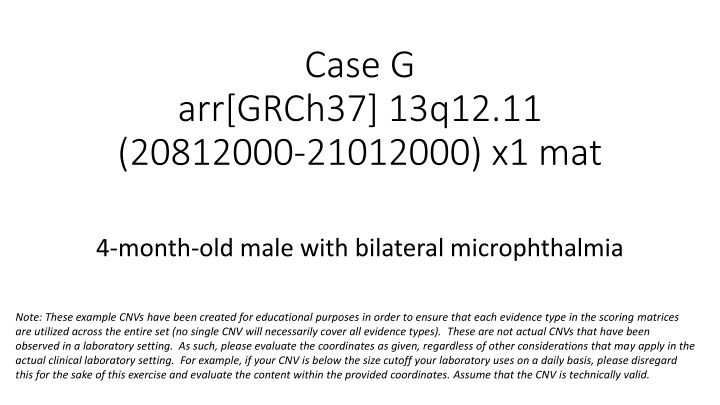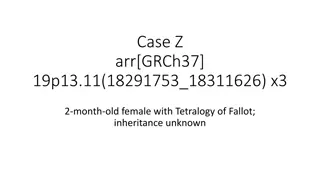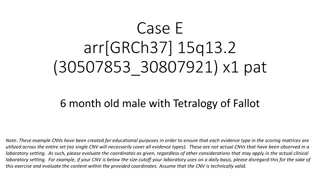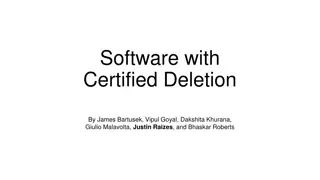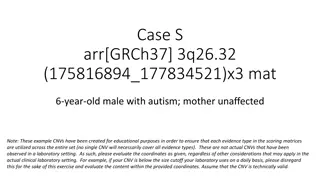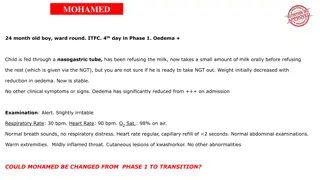Evaluation of Genomic Deletion in a 4-Month-Old Male with Bilateral Microphthalmia
Clinical assessment was conducted on a 4-month-old male with bilateral microphthalmia due to a genomic deletion in the 13q12.11 region. The deletion encompasses part of a protein-coding gene and has been associated with various birth defects and developmental delays in previous cases. Detailed evaluation revealed similarities to deletions observed in individuals with placental mesenchymal dysplasia. Maternal inheritance was reported, highlighting the significance of genetic factors in this rare condition.
Uploaded on Sep 29, 2024 | 3 Views
Download Presentation

Please find below an Image/Link to download the presentation.
The content on the website is provided AS IS for your information and personal use only. It may not be sold, licensed, or shared on other websites without obtaining consent from the author.If you encounter any issues during the download, it is possible that the publisher has removed the file from their server.
You are allowed to download the files provided on this website for personal or commercial use, subject to the condition that they are used lawfully. All files are the property of their respective owners.
The content on the website is provided AS IS for your information and personal use only. It may not be sold, licensed, or shared on other websites without obtaining consent from the author.
E N D
Presentation Transcript
Case G arr[GRCh37] 13q12.11 (20812000-21012000) x1 mat 4-month-old male with bilateral microphthalmia Note: These example CNVs have been created for educational purposes in order to ensure that each evidence type in the scoring matrices are utilized across the entire set (no single CNV will necessarily cover all evidence types). These are not actual CNVs that have been observed in a laboratory setting. As such, please evaluate the coordinates as given, regardless of other considerations that may apply in the actual clinical laboratory setting. For example, if your CNV is below the size cutoff your laboratory uses on a daily basis, please disregard this for the sake of this exercise and evaluate the content within the provided coordinates. Assume that the CNV is technically valid.
Clinical Information arr[GRCh37] 13q12.11(20812000-21012000) x1 mat 4-month-old male with bilateral microphthalmia Microphthalmia is estimated to occur in ~1/10,000 individuals (https://ghr.nlm.nih.gov/condition/microphthalmia#statistics) Maternally inherited Mother reported to be unaffected Use the LOSS scoring metric
Section 1: Initial Assessment of Genomic Content Case G Includes at least part of this gene Would apply category 1A (contains protein-coding or other known functionally important elements), as this deletion includes at least part of a protein-coding gene. 0 points; continue evaluation Total: 0 points
Section 2: Overlap with Established/Predicted HI or Established Benign Genes/Genomic Regions Case G ClinGen Curated Track: Empty! CNV G does not overlap with any currently curated genes/genomic regions. Total: 0 points
2H: Haploinsufficiency Predictors Does not meet criteria Category 2H does not apply. Total: 0 points
Section 3: Evaluation of Gene Number CNV G contains part of a single protein-coding genes (3A, 0 points). Total: 0 points
Section 4: Detailed Evaluation of Genomic Content 13q12.11 deletions Larger deletions of this region (involving multiple genes) have been reported in individuals with various birth defects (choanal atresia, limb abnormalities, etc.) and developmental delays (including PMIDs 22043489, 24807585, 25506395, etc.) A similarly-sized deletion was observed in an individual that died shortly after birth (preterm, at 25 weeks gestation) with placental mesenchymal dysplasia Deletion included CRYL1 and GJB6 Inheritance unknown Finding detected on SNP microarray following amniocentesis These cases are not counted because: phenotypes are disparate, deletions are larger, effects of other genes cannot be ruled out As of May 2020, CRYL1 has not been associated with human disease per OMIM Literature review does not return any substantial information about constitutional loss of CRYL1 Total: 0 points
Case-Control Studies Case G Coe et al. CASES There are a number of similar deletions in the Coe et al. 2014 case- control study. Coe et al. CONTROLS PMID:25217958
Case-Control Studies Note that the data from Coe et al. 2014 is in NCBI36/hg18; once lifted over, these coordinates are very similar to CNV G Deletions were observed in 34 cases referred for clinical microarray testing, and in 17 controls p-value is not significant Confidence interval surrounding the likelihood ratio includes 1 No statistically significant difference between cases and controls- Category 4N (-0.90 points) Total: -0.90 points
Population Data Case G Overlapping population variant gssvL29049
Always check the source and the frequency A frequency of 0.05% is too high to be a plausible cause for a condition that occurs at a frequency of ~1/10,000. However, note that the data comes from the Coe et al. study, which we have already accounted for. Do not count the same evidence twice!
Section 5: Evaluation of Inheritance Pattern/Family History for Patient Being Studied Our patient is an infant with bilateral microphthalmia. The variant is inherited from his unaffected mother. Is this specific or non-specific? In this particular case, it doesn t matter either way, because it is inherited, we will be able to apply enough negative points to take this CNV into a classification of Benign. However, microphthalmia is known to be caused by both genetic and non- genetic causes (e.g., prenatal teratogen exposure), and is associated with numerous different genetic conditions. To be conservative, use Category 5C (- 0.15 points). This is a phenotype for which we can feel quite confident that the mother is truly unaffected Total: -1.05 points
Conclusion Classification: Benign Similar deletions have been observed in individuals in the general population at frequencies too high to be a plausible cause for bilateral microphthalmia, a relatively rare condition. Further, this region has been studied as part of a formal case-control analysis (Coe et al. 2014), and no statistically significant difference was observed between cases and control. The variant is also inherited from an unaffected parent.
